IN THIS ISSUE
- Georgia readies for right whales
- What thread-waisted wasps do
- Snapshot of state's wildlife viewers
- Plus: love for leaf litter; ham-eating pigeons
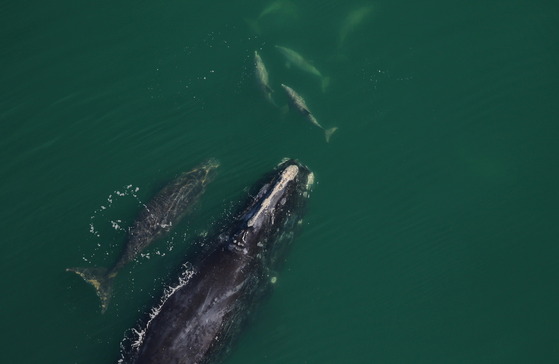 Right whale 1204 (Spindle) and calf with dolphins off St. Catherines Island in January (CMARI, NOAA permit 20556)
With calving season starting soon, here’s the latest on endangered North Atlantic right whales, whose only known calving grounds are off the coast of Georgia, northeastern Florida and South Carolina.
A new population estimate suggests the whales’ steep decline could be easing. After dropping about 25 percent over 10 years to 364 whales in 2021, the North Atlantic Right Whale Consortium estimate for 2022 is 356. One scientist characterized the latest number as “less bad than it has been.”
NOAA research shows more vessel operators following seasonal speed limits to spare right whales in management zones. Critics counter that too many vessels aren’t. NOAA’s bid to expand the limits to vessels as small as 35 feet – the current cutoff is 65 – is on hold. But all boaters are urged slow down and keep watch ("Go slow, whales below").
Senior wildlife biologist Jessica Thompson started this month as DNR’s new lead for marine mammals. Thompson said the East Coast network of agencies and other partners working to save right whales will hopefully not only give the whales "breathing room so their population can potentially rebound, but also help in understanding so much about our coastal ecosystems and how connected they are.
“When one species declines, it affects the whole system.”
HOW YOU CAN HELP
- When boating off Georgia's coast from November to April, follow guidelines for navigating in right whale waters.
- Slow down when boating where right whales are present. Use the Whale Alert app to know if whales are possibly in the area.
- Report sightings by calling 877-WHALE-HELP (877-942-5343).
- If you spot a whale, slow down further, operate at slow speed or put your engine in neutral. Assess the scene and slowly leave the area while keeping watch—other whales could be nearby.
- Stay at least 500 yards from any right whale you see (it’s the law) and never pursue or follow one.
FERNANDINA WHALE FEST
The annual Right Whale Festival this weekend on Amelia Island celebrates the return of right whales to Georgia and north Florida with 100-plus exhibitors. Attractions vary from a beach cleanup and kids program to kayak tours, life-size inflatable whales and live music. Admission is free. The festival is 10 a.m.-6 p.m. Saturday and 10 a.m.-3 p.m. Sunday at Main Beach Park in Fernandina Beach.
|
|
 |
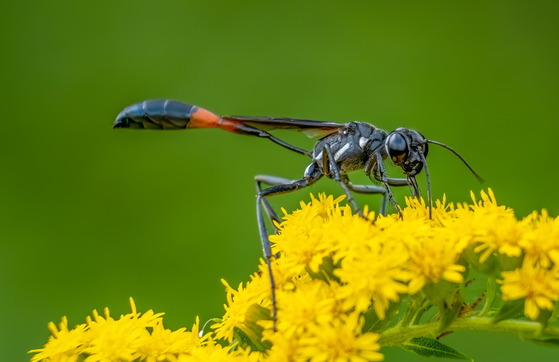 Common thread-waisted wasp on goldenrod blooms
By TERRY W. JOHNSON
When we think about pollinators, creatures such as hummingbirds, butterflies and honeybees usually come to mind.
However, the truth is there is a large suite of other pollinators that are also hard at work pollinating flowering plants. The list of these critters includes the likes of native bees, hoverflies, beetles, flies, moths and wasps.
One of the latter is the thread-waisted wasp. I consider them some of the most underappreciated pollinators in Georgia. The fact they also help control insect pests ranks them as one of our most beneficial insects. …
Read Terry’s column for more on these amazing insects.
Terry W. Johnson is a retired DNR manager and executive director of TERN, friends group of the Wildlife Conservation Section. Check out past columns and his blog. Permission is required to reprint a column.
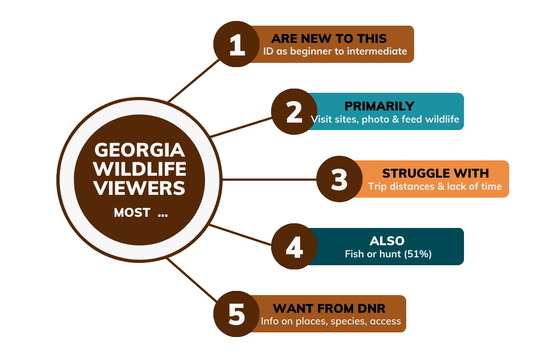 If you consider yourself a Georgia wildlife viewer, how do the five findings above fit?
These are derived from a 2021 sample of about 1,000 Georgians as part of a region- and nationwide survey of wildlife viewers. The survey was done by Dr. Ashley Dayer’s human dimensions lab at Virginia Tech in partnership with the Association of Fish and Wildlife Agencies’ Wildlife Viewing and Nature Tourism Working Group.
In a nutshell, the survey found that most Georgia wildlife viewers:
- Identify as beginners, novices or intermediate viewers.
- List top activities as visiting places to see wildlife, plus feeding and photographing wildlife.
- Consider distance to sites and having time as the main barriers to viewing.
- Are as likely as not to have fished, hunted or done both in the past five years.
- Want DNR to provide more details on where to see wildlife, species and access to viewing ops.
For a deep dive, here’s the full Georgia report in flip-page format, plus a webinar on the national findings. Copies and more are at georgiawildlife.com/wildlifeviewing.
U.S. WILDLIFE VIEWING HIGHLIGHTS
The 2022 National Survey of Fishing, Hunting and Wildlife-associated Recreation released last month adds more data and insights. Consider that:
- More than 148 million U.S. residents – 57 percent of the nation’s 16-and-older population – took part in wildlife viewing in 2022. Also, 39.9 million residents fished and 14.4 million hunted.
- Wildlife-viewing expenditures topped an estimated $250 billion, while spending for fishing and hunting totaled $99 billion and $45 billion, respectively.
- About 91 percent of hunters and 89 percent of anglers also consider themselves wildlife viewers (in which the main objective is closely observing, feeding or photographing wildlife).
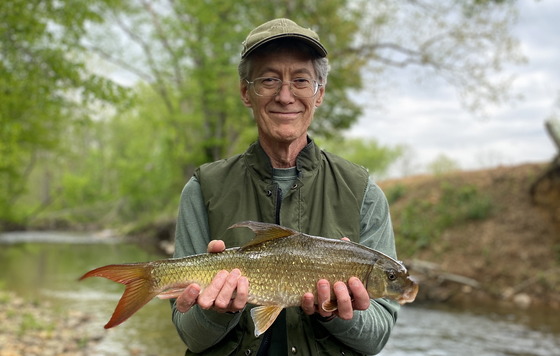 Jon Ambrose with a sicklefin redhorse (Brett Albanese/DNR)
The conservation community joined the family of Dr. Jon Ambrose in mourning his death Oct. 12. Hired in 1986 as DNR’s first ecologist, Ambrose later served as chief of DNR’s Wildlife Conservation Section for a decade until retiring in March. “Beyond his 10 years as section chief, Jon had been a leader for as long as he had been at DNR,” current Chief Matt Elliott writes in the section’s soon-coming annual report. “It’s impossible to overstate how much he did for the agency and how he shaped our future. Beyond this organization, he had a tremendous impact on wildlife conservation in this state and throughout the Southeast. I encourage you to open a copy of ‘The Natural Communities of Georgia’ and get just a small sample of his work.” Among other accomplishments, Ambrose co-authored that comprehensive overview of Georgia’s natural landscapes published by UGA Press.
The recently released Range-wide Conservation Plan for Longleaf Pine (2025-2040) explores the progress and outlook of America’s Longleaf Restoration Initiative. The plan notes an increase in longleaf forests in the Southeast from 3.4 million to approximately 5.2 million acres, with the goal still set at 8 million.
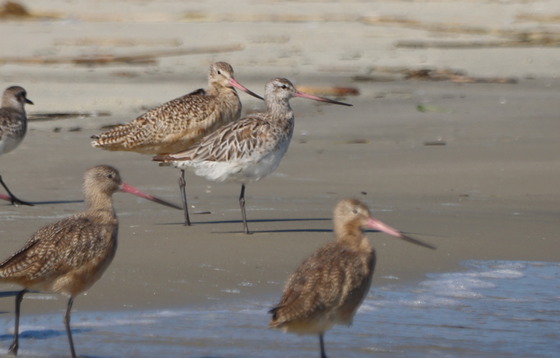 A bar-tailed godwit (center/lighter colored) with marbled godwits on Ogeechee Bar (Tim Keyes/DNR)
Georgia’s first bar-tailed godwit on record was spotted by DNR wildlife biologist Tim Keyes and technician Sam Murray during a shorebird survey on Ogeechee Bar Tuesday. These gangly waders that nest across the Eurasian Arctic and into Alaska had been reported in some other Atlantic Coast states but not Georgia. Although foraging with a flock of 100-plus marbled godwits at the mouth of the Ogeechee River, this bird “stood out like a sore thumb – being smaller and paler,” Keyes said, adding that he and Murray carefully confirmed it wasn’t a Hudsonian godwit, also rare but occasionally seen in Georgia.
Bar-tailed godwits, by the way, are the long-distance champions of flying. Last year, a satellite-tagged juvenile flew more than 8,400 miles nonstop from Alaska to southern Australia, an 11-day marathon by wing that topped the previous record of 8,100 miles set by another bar-tailed godwit.
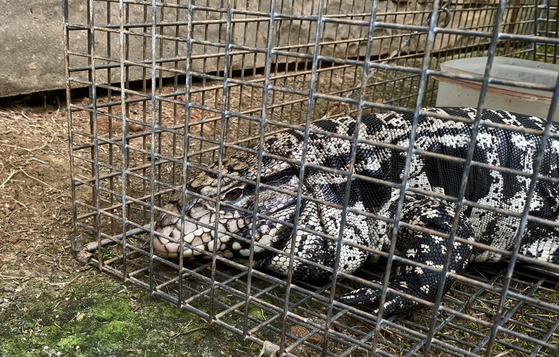 Argentine black and white tegu trapped in Athens (Rick Lavender/DNR)
A 3-foot-long tegu loose and living under a porch in Athens is just one example of why DNR is requiring pet owners to tag and register six reptile species newly regulated as wild animals. And with the deadline to register only weeks away, DNR’s Dr. Brett Albanese said pet owners “need to schedule (tagging) with their vet now.”
With Georgia a top 10 state in installed solar capacity and more solar farms being planned, the Georgia Utility Scale Solar Siting Initiative Partnership is recommending siting and design practices to minimize, mitigate or eliminate negative impacts on wildlife from the facilities. A low-impact siting tool, webinar forum and other resources are available at georgiawildlife.com.
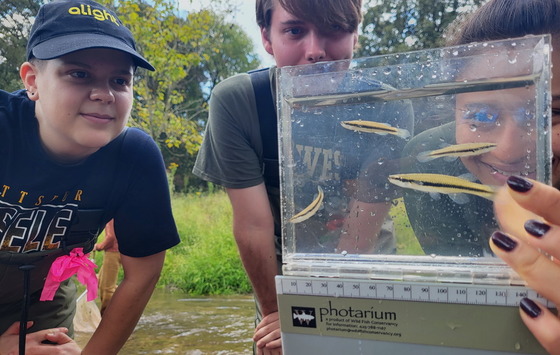 Dalton State students with blackspotted topminnows at a Dade County creek (Ani Escobar/DNR)
Quick hits:
 Sea Turtle Cooperative members at DNR offices in Brunswick (DNR)
Names in the news: Members of the Georgia Sea Turtle Cooperative capped off a successful nesting season – nearly 3,500 nests monitored – with their annual wrap-up meeting in late September. In addition to Dr. Jon Ambrose (see above), the Wildlife Conservation Section is remembering retired GIS specialist Chris Canalos of Athens, who died Sept. 26, and wildlife technician Ashley Harrington of Culloden, who passed Oct. 17. Col. Mike England has been named director of DNR’s Law Enforcement Division, following Col. Thomas Barnard's move to DNR deputy commissioner. In turn, the division promoted James McLaughlin from captain to lieutenant colonel.
 Pileated woodpecker (Jenny Burdette/GNPA)
"Wicked Wildlife Wednesday" looks at a woodpecker's tongue, DNR
DNR commissioner discusses hunting safety, DNR
Bald eagles prep nest at Berry College, Berry College
Sampling deer for chronic wasting disease, DNR
Elk play in snow on interstate wildlife overpass, Central Oregon Daily News
Glowing scorpion, Colorado Parks and Wildlife
(+video) "DNR reminds pet owners to tag, register non-native reptiles," WMGT-TV (Macon) and others, including UPI and WSB-TV/Atlanta ("Homeowner shocked after kids tell her about ‘giant lizard’ found under home")
"Burmese pythons and these other animals soon need to be registered in Georgia," WMAZ-TV (Macon)
"Bye-bye, bats? Georgia's bat population is declining," WALB-TV (Albany)
"Former 'leader' of turtle smuggling ring arrested in Bibb on animal cruelty charges," WMAZ-TV (Macon)
(+audio) "Right whale population steadying, but human-caused injuries remain high," Maine Public Radio
"Endangered right whale species speeding towards extinction," Phys.org
"Oxbow Meadows' expansion benefits region’s most bird-brained visitors," Columbus State University
"21 species declared extinct, U.S. Fish and Wildlife Service says," Georgia Public Broadcasting. Also: The Augusta Chronicle.
"Go Fish Education Center temporarily closes for upgrades," WGXA-TV (Macon)
"Wild pig populations in U.S. can be managed," UGA Today
"Billion-dollar plan to save salmon depends on giant fish vacuum," ProPublica
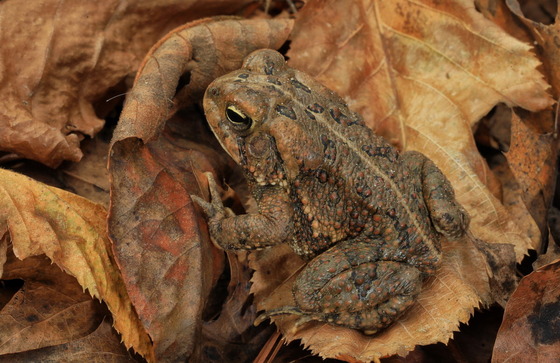 Fowler's toad in leaf litter (Alan Cressler)
As leaves blanket your yard this fall, it may be tempting to clear all of them away. But leaf litter can be a crucial winter home for small mammals, insects and amphibians. Fallen leaves provide warmth, protection and even food that help these animals survive the harsh winter months. The next time you’re cleaning up the yard, consider leaving some leaves for wildlife. Learn more in the American Museum of Natural History’s “Life in the Leaf Litter” (download).
- Ethan Hatchett
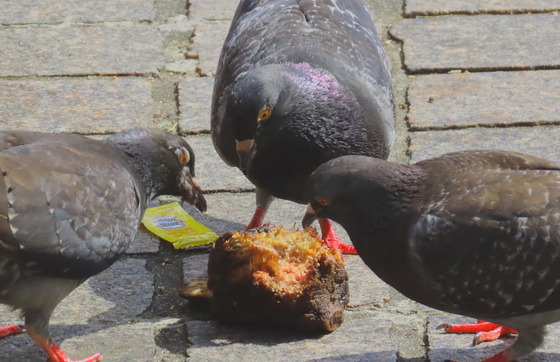 On the heels of Halloween, this photo of pigeons pecking at what looks like a ham hock on an Atlanta sidewalk seems appropriate. Quipped DNR’s Dr. Bob Sargent, who photographed the mix in May, “Just goes to show that even ‘harmless, seed-eating street birds’ will go full-bore carnivore if offered a quality roast!”
CREDIT
Masthead: Right whale #1208 (Medusa) and calf seen in December 2022 about 22 nautical miles off Sapelo Island. (Clearwater Marine Aquarium Research Institute/NOAA permit 20556)
Top
|